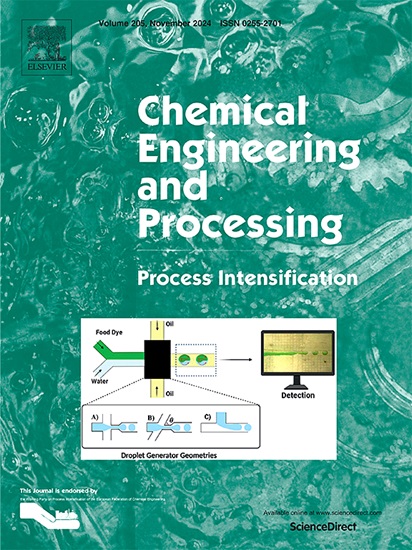An in-depth analysis of Pebax-1657/GO-silica/PEI thin film nano-composite membranes for gas dehydration
IF 3.8
3区 工程技术
Q3 ENERGY & FUELS
Chemical Engineering and Processing - Process Intensification
Pub Date : 2025-02-06
DOI:10.1016/j.cep.2025.110206
引用次数: 0
Abstract
This research aimed to study the effectiveness of blending Pebax-1657 polymer with GO/SiO2 nanoparticles in developing TFN membranes for N2 gas dehydration. Different concentrations of nanoparticles (0 %, 0.5 %, and 1 %) were incorporated using dip coating. The nanocomposites were analyzed for their chemical structure, morphology, topology, and thermal stability using FTIR, SEM, CA, AFM, and TGA. The results showed that the samples had good thermal stability and a highly hydrophilic surface. The MP0.5–0.5 membrane with 0.5 % GO/SiO2 nanoparticles demonstrated improved performance in water vapor and N2 permeance at 2 × 105 to 6 × 105 Pa pressure and 70 % relative humidity. The addition of 0.5 % GO nanoparticles to the sample further enhanced H2O and N2 permeance and separation factor. However, in the case of the MP0.5–0.5 membrane, a different scenario unfolds, showcasing a synergistic effect and the ideal morphology was observed. The water vapor and nitrogen permeance of the MP0.5–0.5 membrane, under 2 × 105 to 6 × 105 Pa pressure and 70 % humidity, reaches from GPU 158 and GPU 0.23 (for the neat mebrane) to GPU 969 and GPU 31, respectively. The H2O/N2 separation factor was recorded as 679.It was observed that the relative humidity of the gas decreased from approximately 70 % to about 1.2 % during the membrane step, indicating the high efficiency of the membrane. The investigation concluded that the TFN membranes' dehydration characteristics are influenced by various factors, including morphology, plasticization, and hydrophilic properties. Changes in the feed gas flow rate also affected separation factor and nitrogen permeance. The rise in sweep gas flow had a notable impact on enhancing the membrane's separation factor by decreasing the transmembrane concentration gradient. Consequently, a trade-off emerges between water vapor flux and separation factor when employing the sweep gas stream. These discoveries are highly valuable in industrial settings, as they offer a more profound understanding of the topic.

Pebax-1657/ go -二氧化硅/PEI薄膜纳米复合膜气体脱水的深入分析
本研究旨在研究Pebax-1657聚合物与氧化石墨烯/二氧化硅纳米颗粒共混制备用于氮气脱水的TFN膜的有效性。不同浓度的纳米颗粒(0%,0.5%和1%)采用浸渍涂层。利用FTIR、SEM、CA、AFM和TGA等分析了纳米复合材料的化学结构、形貌、拓扑结构和热稳定性。结果表明,该样品具有良好的热稳定性和高度亲水性。在2 × 105 ~ 6 × 105 Pa压力和70%相对湿度条件下,含有0.5%氧化石墨烯/二氧化硅纳米颗粒的mp0.5 ~ 0.5膜的水蒸气和氮气渗透性得到改善。在样品中加入0.5%的氧化石墨烯纳米颗粒,进一步提高了水和N2的渗透率和分离系数。然而,在MP0.5-0.5膜的情况下,呈现出不同的情况,显示出协同效应,并观察到理想的形态。在2 × 105 ~ 6 × 105 Pa压力和70%湿度下,mp0.5 ~ 0.5膜的水蒸气透过率从GPU 158和GPU 0.23(纯膜)到GPU 969和GPU 31。水/N2分离系数为679。结果表明,在膜步骤中,气体的相对湿度从70%左右下降到1.2%左右,表明膜的效率很高。研究表明,TFN膜的脱水特性受到多种因素的影响,包括形态、塑化和亲水性。进料气流量的变化也会影响分离系数和氮渗透率。扫气流量的增加通过降低膜间浓度梯度对膜分离系数的提高有显著影响。因此,当采用扫描气流时,在水蒸气通量和分离因子之间出现了权衡。这些发现在工业环境中非常有价值,因为它们提供了对该主题更深刻的理解。
本文章由计算机程序翻译,如有差异,请以英文原文为准。
求助全文
约1分钟内获得全文
求助全文
来源期刊
CiteScore
7.80
自引率
9.30%
发文量
408
审稿时长
49 days
期刊介绍:
Chemical Engineering and Processing: Process Intensification is intended for practicing researchers in industry and academia, working in the field of Process Engineering and related to the subject of Process Intensification.Articles published in the Journal demonstrate how novel discoveries, developments and theories in the field of Process Engineering and in particular Process Intensification may be used for analysis and design of innovative equipment and processing methods with substantially improved sustainability, efficiency and environmental performance.

 求助内容:
求助内容: 应助结果提醒方式:
应助结果提醒方式:


